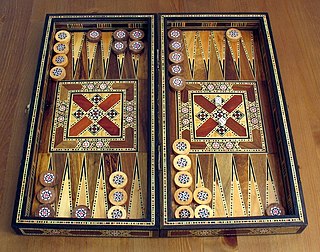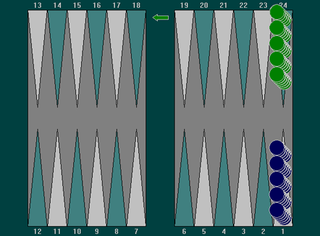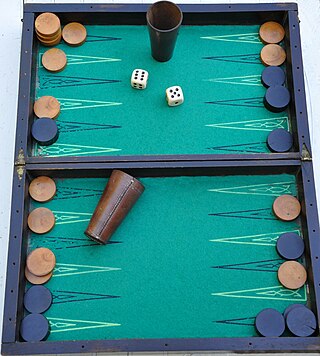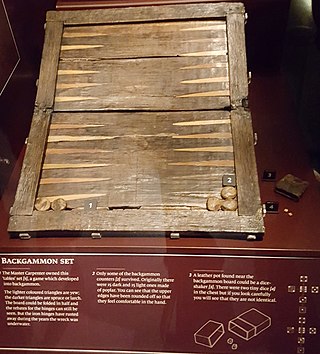
Backgammon is a two-player board game played with counters and dice on tables boards. It is the most widespread Western member of the large family of tables games, whose ancestors date back nearly 5,000 years to the regions of Mesopotamia and Persia. The earliest record of backgammon itself dates to 17th-century England, being descended from the 16th-century game of Irish.

Tables games are a class of board game that includes backgammon and which are played on a tables board, typically with two rows of 12 vertical markings called points. Players roll dice to determine the movement of pieces. Tables games are among the oldest known board games, and many different varieties are played throughout the world. They are called 'tables' games because the boards consist of four quadrants or 'tables'. The vast majority are race games, the tables board representing a linear race track with start and finish points, the aim being to be first to the finish line, but the characteristic features that distinguish tables games from other race games are that they are two-player games using a large number of pieces, usually fifteen per player.

Nard is an historical Persian tables game for two players that is sometimes considered ancestral to backgammon. It is still played today, albeit in a different form. As in other tables games, the playing pieces are moved around a board according to rolls of dice. It uses a standard tables board, but has a different opening layout and rules of play from that of backgammon.

Acey-deucey is a tables game, a family of board games that includes backgammon. Since World War I, it has been a favorite game of the United States Navy, Marine Corps, and Merchant Marine. Some evidence shows that it was played in the early 1900s aboard U.S. Navy ships. The game is believed to be rooted in the Middle East, Greece, or Turkey, where there were variants in which the game started with pieces off the board.
Ruff and Honours, Ruffe and Trump or Slamm was an English trick-taking card game that was popular in the 16th and 17th centuries; it was superseded in the 18th century by Whist.

Gul bara is a tables game, an ancient genre of board games that includes Backgammon, Trictrac and Nard. It is also called Rosespring Backgammon or Crazy Narde. The aim of the game is to move all of one's men around the board and bear them off. The first player who bears off all his or her men wins. The game is popular in Bulgaria, Azerbaijan, Greece, Turkey and North Macedonia.

Plakoto (Πλακωτό) is a tables game for two players that is popular in Greece. The object is for the player to bring all 15 pieces around to his or her own home board and then bear them off. The player who bears off all 15 pieces first wins the game. This game is usually played along with two other variants, Févga and Pórtes. Together these three games are called Távli, and are played in sequence usually one after the other. Game is three, five or seven points. A Bulgarian version of Plakoto is known as Tapa and also as Tsillitón (Τσιλλιτόν), in Cyprus. Parlett places Plakoto in the same group as the popular mediaeval game of English, as well as the French games of Tieste and Impérial, the Italian game of Testa and Spanish Emperador.

Jacquet is a tables game, played on the same type of board as Backgammon, that was once very popular in France and several other parts of Europe. It probably emerged around 1800, but is attested by 1827. In the 20th century it replaced the classic French backgammon equivalent — the game of Trictrac — until Jacquet itself was superseded by Anglo-American games in the 1960s.

Trictrac is a French board game of skill and chance for two players that is played with dice on a game board similar, but not identical, to that of backgammon. It was "the classic tables game" of France in the way that backgammon is in the English-speaking world.
The Compleat Gamester, first published in 1674, is one of the earliest known English-language games compendia. It was published anonymously, but later attributed to Charles Cotton (1630–1687). Further editions appeared in the period up to 1754 before it was eclipsed by Mr. Hoyle's Games by Edmond Hoyle (1672–1769).

Tourne Case or Tourne-Case is an historical French tables game in the same family as Backgammon. Lalanne recommends it as a children's game.

Laquet is an historical Castilian tables game that was described as a new game in the 13th century. It may be the ancestor of Jacquet. Unlike Backgammon and most other tables games, it has an asymmetrical starting position; only three of the four quadrants are used and the pieces may not be 'hit'.

The following is a glossary of terms used in tables games, essentially games played on a Backgammon-type board. Terms in this glossary should not be game-specific, but applicable to a range of tables games.

Irish or the Irish Game was an Anglo-Scottish tables game for two players that was popular from the 16th to the mid-18th centuries before being superseded by its derivative, the "faster paced" backgammon. In its day, Irish was "esteemed among the best games at Tables." Its name notwithstanding, Irish was one of the most international forms of tables games, the equivalent of French toutes tables, Italian tavole reale and Spanish todas tablas, the latter name first being used in the 1283 El Libro de los Juegos, a translation of Arabic manuscripts by the Toledo School of Translators.

Ludus Anglicorum, also called the English Game, is an historical English tables game for two players using a board similar to that used today for Backgammon and other games. It is a "strategic game for serious game-players" and was well known in the Middle Ages. At one time it was considered the most popular tables game in England.

Ticktack or Tick-Tack, is an historical English tables game for two players using a board similar to that used today for Backgammon and other tables games. Like its much more elaborate French counterpart, Trictrac, it has the unusual feature that there are several different ways in which it can be won, including Toots and Rovers.
Verquere is an historical tables game. It was played by two players on the same tables board and with the same set of men as backgammon.

Long Nardy, also just Nardy, is a Russian tables game for two players. It is also played in Armenia as Long Nardi or Nardi. It probably originated in the historical Persian game of Nard. It requires a tables board, 15 men apiece and two dice.
Tawula, sometimes also called Turkish Backgammon in English, is an historical tables game once popular in Asia Minor and Egypt.

Gioul is a tables game for two players that is common in the Levant and may have originated in Turkey. The set up and play are as in Greek Plakoto, blocking is as in Moultezim and doublets are very powerful as in the game of Gul Bara.
















